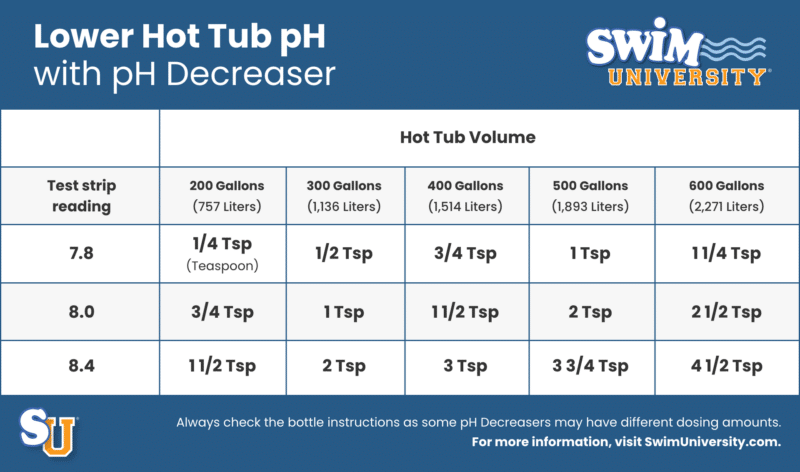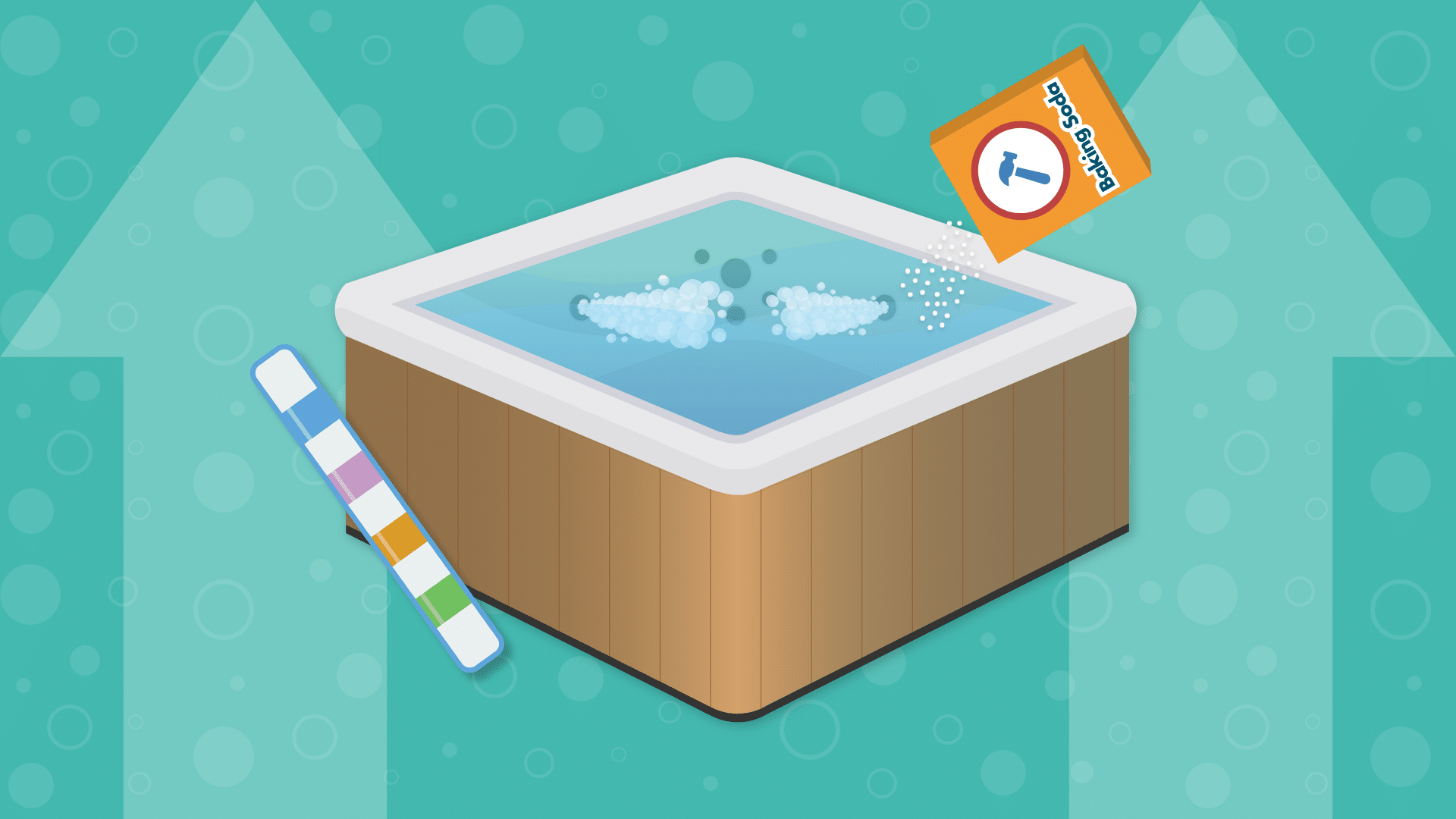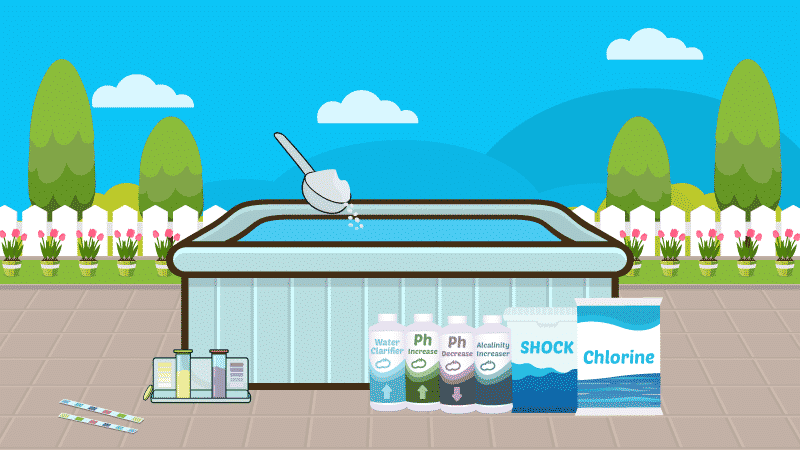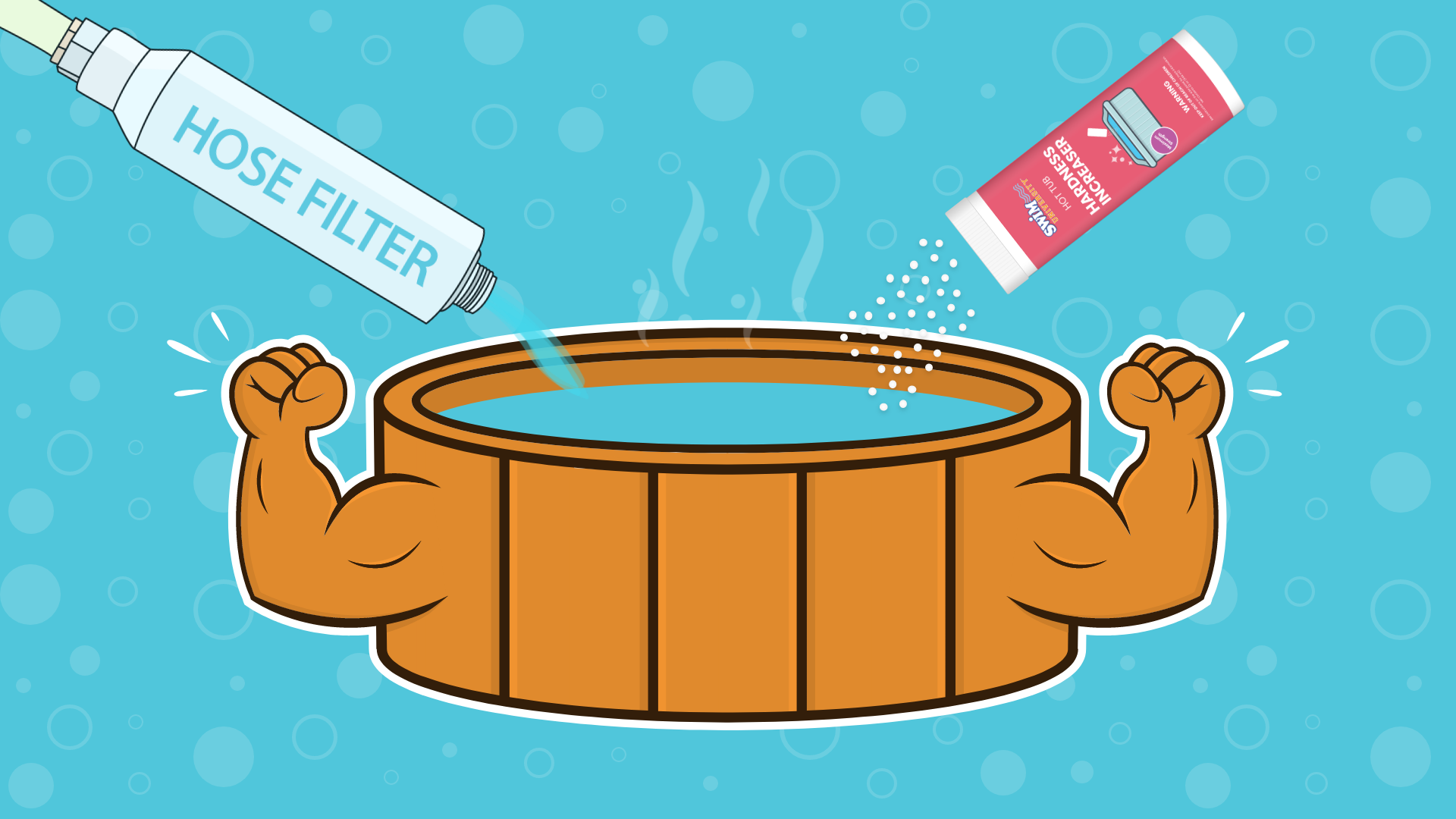How to Lower pH in a Hot Tub
The best way to lower pH in your hot tub or swim spa is by using a product called
Lower your hot tub pH with a pH decreaser. High pH can damage your hot tub equipment, cause cloudy water, and irritate eyes and skin.
I recommend you stick with a product made for hot tubs to maintain a pH balance instead of using a household cleaner.
For example, you might read that you can use white vinegar to lower the pH. This is technically true. White vinegar is a liquid acetic acid. But products vary in strength, and there are no charts to tell you how much to add. You’d be guessing every time. Plus, who wants to soak in a salad dressing?
Use the proper amount of pH descreaser and keep your pH reading between 7.4 and 7.6. You can use a test strip to find out your current reading and use the chart below to add the correct amount every time. 👇

How to lower pH in a hot tub with vinegar
You can add 1/2 cup (118 ml) of white vinegar for every 100 gallons (379 l) of hot tub water. Avoid using stronger cleaning vinegar. You can also use citric acid at the same amount. Add these chemicals with the jets on low and wait 5 minutes to test the water before adding more.
Learn how to keep your hot tub clear while saving money so you can enjoy more soaking time without big costs. The Hot Tub Handbook covers every type of hot tub on earth.
Understanding High pH in Hot Tubs (and Why It Matters)
High pH in your spa water causes your water to feel dry. This can irritate your skin, cause scaling, and make your chlorine or bromine less effective.
A high pH level can also damage your heater over time. The more scale that builds up on your heating element, the more energy your hot tub will need to stay hot. This will end up costing you more on your electric bill. And even worse, you may have to replace your heater and pump.
On top of all that, if your hot tub water is cloudy, chances are you have high pH.
What Causes High pH in a Hot Tub?
- Your local water source (city or well) could have a high starting pH. Check your local water supplier to find out.
- You added too much pH increaser, Alkalinity Increaser, or Baking Soda.
- You added too much chlorine or bromine (which actually raises the pH of your water).
- You have a saltwater hot tub, which may naturally have a high pH
- Someone soaking in your hot tub has lotions or cosmetics on their skin that have a high pH.
How to Measure Hot Tub pH (and Total Alkalinity)
pH (potential of hydrogen) is measured on a scale from 0 to 14. Zero is battery acid, and 14 is closer to drain cleaner or bleach. Both ends of the spectrum would be terrible to soak in.

The goal is to keep your pH balanced at around 7 (which is right in the middle of the scale). For hot tubs, you want it slightly higher at 7.4 to 7.6. And the decimals matter! Each point equals 10 times the amount.
For example, 7.5 is 10 times higher than 7.4.
The best and easiest way to test for pH (and alkalinity) in your hot tub is to use a test strip. I prefer test strips because they’re cheap, fast, and close enough.
Liquid test kits and digital readers are expensive but more accurate. But we’re not chemists; we’re just trying to soak in safe water. Test strips are fine. Here is my favorite brand of hot tub test strips. 👇
Tests for 7 important chemistries in seconds: Total Hardness, Total Chlorine, Total Bromine, Free Chlorine, pH, Total Alkalinity, and Cyanuric Acid.
What About Hot Tub Alkalinity? This is a Must-Read for Hot Tub Owners…
The pH is the measure of how acidic your hot tub chemistry is. But that’s only half the story. The alkalinity level is another reading you need to stay on top of.
Without alkalinity in your water, your pH would be all over the place, and you’d never be able to keep it perfectly balanced.
Alkalinity is pH’s bodyguard. It takes the hit, so your pH remains stable. So, you need both readings to be at the proper levels for your hot tub to be balanced.
But unlike pH, alkalinity has a much larger scale from 0 to over 500, and it’s measured in parts per million or PPM
- Ideal Alkalinity range: 100 PPM to 150 PPM
- Ideal pH range: 7.4 to 7.6
An Important Note About pH and Alkalinity Ranges
You might see conflicting ranges on the internet and on hot tub chemical bottles. This is normal. I like to keep alkalinity higher, so I’m not adding it to the hot tub as often. But if you want, you can keep your alkalinity as low as 80 PPM and your pH as low as 7.2. Even the CDC recommends this.
How to Lower pH in a Hot Tub (Step by Step)
This is my simple process for lowering pH. Follow these steps every time you need to do this.
1. Know Your Hot Tub Size
Before you can test and adjust your pH, you need to know how many gallons of water your hot tub holds. You can Google your hot tub make and model or call a dealer that sells your hot tub brand.
2. Test the Water
Dip a test strip directly in the water (as close to the center of the tub as possible) and wait 15 seconds. Match up the colors on the back of the bottle. If you’re colorblind, get someone else to read the results. Or you can take a water sample to your local hot tub supply store to get tested.
3. Decrease the pH using pH Decreaser
Use the chart below to determine how much pH descreaser to add to the hot tub.

Add the chemical directly to the water while the hot tub jets are running on low. This will help it mix in quickly. Wait 5 minutes, and then retest the water again to make sure you’re in the ideal range (7.4 to 7.6). Add more if needed.
If you added too much, don’t worry. Check out our guide on how to raise pH in a hot tub.
A Quick Word About Chemical Safety
I highly recommend using gloves (and goggles) when you handle any hot tub chemicals.
Frequently Asked Questions About Lowering pH in Hot Tubs
We asked what confused you the most about lowering the pH in your hot tub, and we answered!
How do I bring the pH down in my hot tub?
To lower the pH in your hot tub, you can use a commercial
What happens if the pH is too high in the hot tub?
High pH can lead to problems like scale buildup, cloudy water, inefficient sanitizer performance, and skin and eye irritation.
Does baking soda lower pH in hot tubs?
No, baking soda (sodium bicarbonate) does not lower the pH in a hot tub. In fact, it’s typically used to raise the pH and alkalinity levels when they are too low.
Can I use white vinegar to lower the pH in a hot tub?
Yes, white vinegar can be used to lower the pH of the water in a hot tub. Add 1/2 cup (118 ml) for every 100 gallons (379 l) gradually and test the water frequently to avoid overshooting the desired pH level.
How do I lower the pH in my hot tub without lowering the alkalinity?
To lower pH without significantly affecting alkalinity, use a
Which is worse, high pH or low pH?
Both high and low pH levels can be problematic in a hot tub. High pH can cause scaling and ineffective sanitization, while low pH can lead to corrosion and user discomfort. Maintaining a balanced pH is critical.
How do I lower the pH and alkalinity in my hot tub?
To lower alkalinity and pH, you can use a commercial pH and alkalinity Decreaser or muriatic acid. Always follow the manufacturer’s instructions and handle chemicals safely.
Does chlorine raise or lower pH?
Chlorine can raise the pH level in hot tub water, especially when using chlorine-based shock treatments, which tend to have a high pH.
3 Ways We Can Help With Your Hot Tub
- Hot Tub Cheat Sheets (Free): Easy-to-use guides to help you keep your hot tub water balanced and sanitized.
- The Hot Tub Handbook: An illustrated guide to DIY hot tub care, including water chemistry, maintenance, troubleshooting, and more.
- The Hot Tub Care Course. You’ll get step-by-step videos and a step-by-step downloadable guide with everything you need to know about hot tub maintenance.











